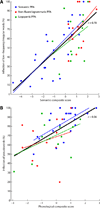Inflectional morphology in primary progressive aphasia: an elicited production study
- PMID: 25129631
- PMCID: PMC4159758
- DOI: 10.1016/j.bandl.2014.07.001
Inflectional morphology in primary progressive aphasia: an elicited production study
Abstract
Inflectional morphology lies at the intersection of phonology, syntax and the lexicon, three language domains that are differentially impacted in the three main variants of primary progressive aphasia (PPA). To characterize spared and impaired aspects of inflectional morphology in PPA, we elicited inflectional morphemes in 48 individuals with PPA and 13 healthy age-matched controls. We varied the factors of regularity, frequency, word class, and lexicality, and used voxel-based morphometry to identify brain regions where atrophy was predictive of deficits on particular conditions. All three PPA variants showed deficits in inflectional morphology, with the specific nature of the deficits dependent on the anatomical and linguistic features of each variant. Deficits in inflecting low-frequency irregular words were associated with semantic PPA, with lexical/semantic deficits, and with left temporal atrophy. Deficits in inflecting pseudowords were associated with non-fluent/agrammatic and logopenic variants, with phonological deficits, and with left frontal and parietal atrophy.
Keywords: Inflectional morphology; Primary progressive aphasia; Semantic dementia.
Copyright © 2014 Elsevier Inc. All rights reserved.
Figures



Similar articles
-
The Brain Network of Naming: A Lesson from Primary Progressive Aphasia.PLoS One. 2016 Feb 22;11(2):e0148707. doi: 10.1371/journal.pone.0148707. eCollection 2016. PLoS One. 2016. PMID: 26901052 Free PMC article.
-
Healthy brain connectivity predicts atrophy progression in non-fluent variant of primary progressive aphasia.Brain. 2016 Oct;139(Pt 10):2778-2791. doi: 10.1093/brain/aww195. Epub 2016 Aug 6. Brain. 2016. PMID: 27497488 Free PMC article.
-
Longitudinal changes in brains of patients with fluent primary progressive aphasia.Brain Lang. 2014 Apr;131:11-9. doi: 10.1016/j.bandl.2013.05.012. Epub 2013 Jun 21. Brain Lang. 2014. PMID: 23796527
-
The neural basis of syntactic deficits in primary progressive aphasia.Brain Lang. 2012 Sep;122(3):190-8. doi: 10.1016/j.bandl.2012.04.005. Epub 2012 Apr 29. Brain Lang. 2012. PMID: 22546214 Free PMC article. Review.
-
Primary Progressive Aphasia and Stroke Aphasia.Continuum (Minneap Minn). 2018 Jun;24(3, BEHAVIORAL NEUROLOGY AND PSYCHIATRY):745-767. doi: 10.1212/CON.0000000000000618. Continuum (Minneap Minn). 2018. PMID: 29851876 Free PMC article. Review.
Cited by
-
Reading words and other people: A comparison of exception word, familiar face and affect processing in the left and right temporal variants of primary progressive aphasia.Cortex. 2016 Sep;82:147-163. doi: 10.1016/j.cortex.2016.05.014. Epub 2016 Jun 9. Cortex. 2016. PMID: 27389800 Free PMC article.
-
More than a piece of cake: Noun classifier processing in primary progressive aphasia.Alzheimers Dement. 2024 Apr;20(4):2353-2363. doi: 10.1002/alz.13701. Epub 2024 Jan 29. Alzheimers Dement. 2024. PMID: 38284802 Free PMC article.
-
One cat, Two cats, Red cat, Blue cats: Eliciting morphemes from individuals with primary progressive aphasia.Aphasiology. 2021;35(12):1-12. doi: 10.1080/02687038.2020.1852167. Epub 2021 Mar 16. Aphasiology. 2021. PMID: 35002009 Free PMC article.
-
Online sentence processing impairments in agrammatic and logopenic primary progressive aphasia: Evidence from ERP.Neuropsychologia. 2021 Jan 22;151:107728. doi: 10.1016/j.neuropsychologia.2020.107728. Epub 2020 Dec 14. Neuropsychologia. 2021. PMID: 33326758 Free PMC article.
-
Shave, shear, shred, or cut: PPA variant differentially impacts erroneous responses produced in a confrontation naming test of verbs.Aphasiology. 2024;38(8):1428-1440. doi: 10.1080/02687038.2024.2311963. Epub 2024 Feb 5. Aphasiology. 2024. PMID: 39056000 Free PMC article.
References
-
- Albright A, Hayes B. Rules vs. analogy in English past tenses: a computational/experimental study. Cognition. 2003;90:119–161. - PubMed
-
- Ashburner J. A fast diffeomorphic image registration algorithm. NeuroImage. 2007;38:95–113. - PubMed
-
- Ashburner J, Friston KJ. Unified segmentation. NeuroImage. 2005;26:839–851. - PubMed
Publication types
MeSH terms
Grants and funding
LinkOut - more resources
Full Text Sources
Other Literature Sources

